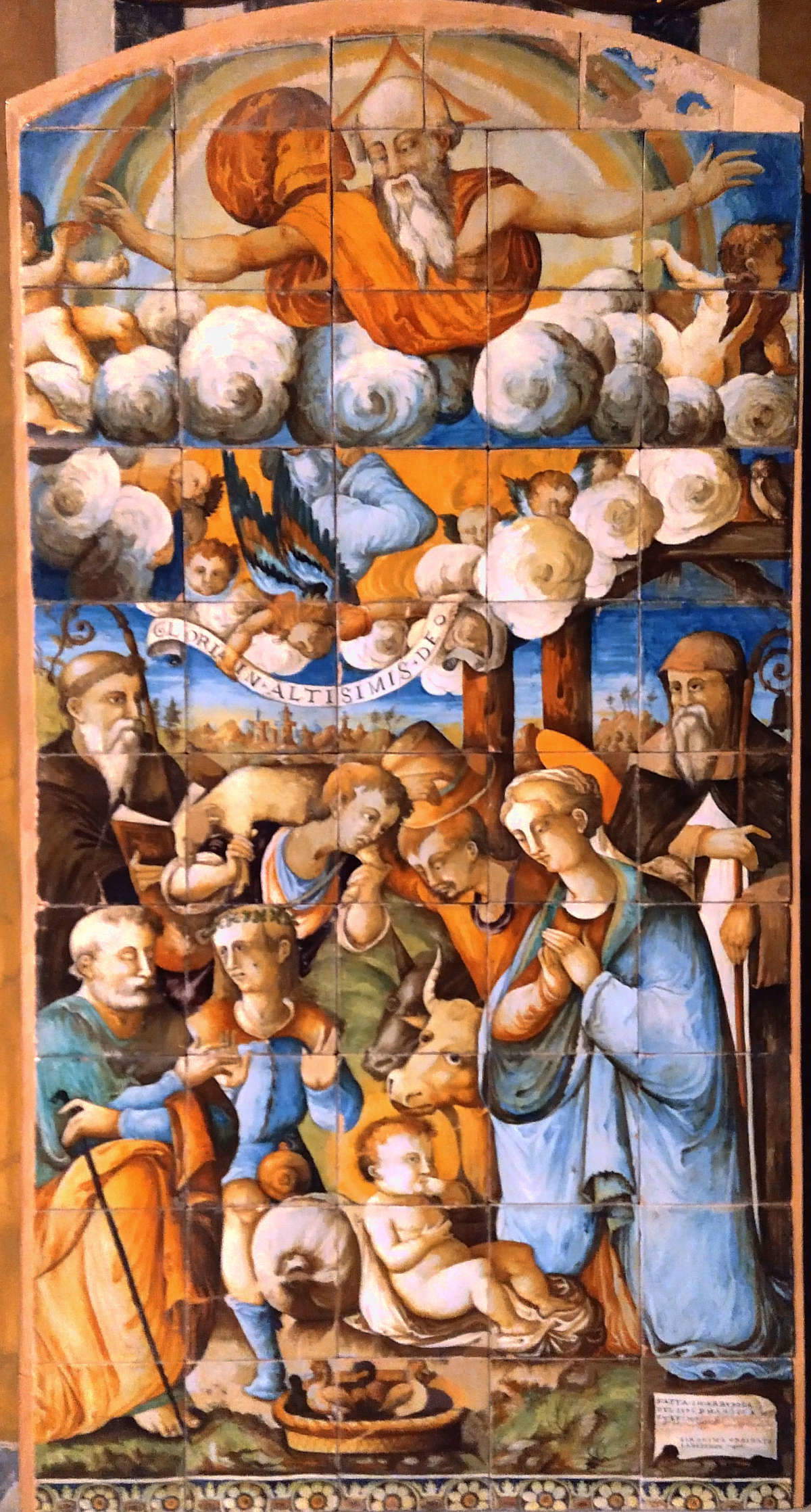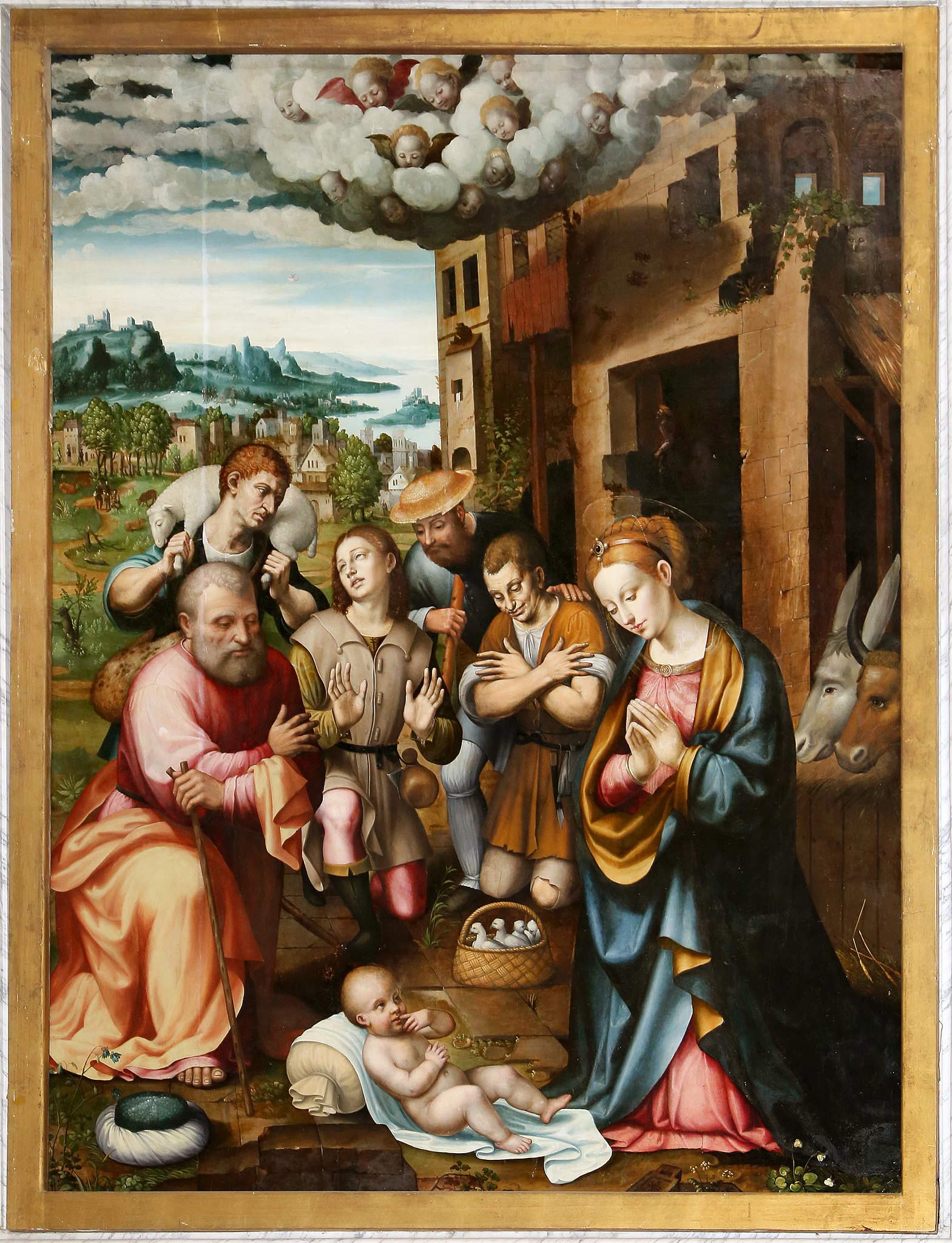A nativity scene painted on pottery: the 16th-century altarpiece in the church of Albissola Marina
In the church of Albissola Marina, the parish church of Our Lady of Concord, there is a beautiful painted nativity scene, from the 16th century, placed near the altar. And so far so good: there are countless churches that at some point present the faithful with an altarpiece depicting an Adoration of the Child. This one, however, has a rather rare peculiarity: it is entirely painted on majolica. In the city of ceramics, in one of the territories that have most closely linked their fortunes to the practice of this very ancient art, the main church welcomes those who approach the altar with an extraordinary sampling of what can be done with a little earth and a little color. We also know who its authors are, because in the lower right corner there is a cartouche that says “Fatta in Arbisola / del 1576 p mano di Augustino [...] Gironimo Urbinato painted it.”
A four-handed work, then. A certain Augustino, whose surname we unfortunately do not know (the part of the cartouche bearing it has been erased), took care of the ceramic work, while a painter, a certain Gerolamo Urbinate, was entrusted with the images. The modes, in fact, are reminiscent of those of the historiated ceramics that were produced in Urbino in the second half of the sixteenth century: after all, the presence in the Savona area at that time of masters from the Marche region who had left their lands and had helped to orient the taste of local ceramics is attested. The colors are those of 16th-century Urbino ceramics: a great prevalence of blues and yellows variously declined, sparse notes of green, a few earthy tones to give a little depth. The image, however, is proudly Savonese: Gerolamo Urbinate was inspired by Antonio Semino’sAdoration of the Shepherds , painted in 1535 and preserved in the church of San Giovanni Battista in Savona, one of the Genoese painter’s most moving works. Jerome provides a more colloquial, familiar translation of it, freely revisiting some elements.


The Virgin and St. Joseph are in the same position: she is kneeling, praying with clasped hands to the Child lying in front of her, on the earth (and not on a terracotta floor as in Semino), and who like any newly born child puts his fingers in his mouth. In the majolica altarpiece, Mary appears much larger than her groom: evidently Gerolamo Urbinate did not handle the space he had well. And then, his Saint Joseph seems asleep, perhaps bored by the shepherd standing beside him and turning as if to look at him, almost as if to say something to him, to talk to him: in Semino’s painting, on the other hand, the young shepherd looked ecstatically up to heaven. Then there is the shepherd with the lamb on his shoulders, but the other two who flanked him in Semino’s painting become one person: a shepherd who takes off his hat as a sign of deference, and at the same time leans over to look better at the Child. The ox and the donkey peek out, somewhat impertinently, under the Virgin’s sleeve, not quite clear where they came from, whereas in Semino’s altarpiece they were, more consistently, inside the hut on the right. The same hut in the background, in the Albissola altarpiece, is no longer Semino’s ruined stable, but becomes a simple wooden berceau , and likewise the city in the background appears less detailed, described with less brio: instead, the depiction of the sky is much more swirling, opening up to show the figure of the All-Father, appearing within a half-painted mandorla. It is more than likely, however, that the part with the figure of God is a later addition: not counting the fact that Semino’s painting also breaks off earlier, there is a drop in quality and an obvious discontinuity between the third and fourth rows of tiles. Then there are two presences added by Girolamo Urbinate compared to Semino’s painting, namely the St. Benedict and St. Anthony the Abbot seen at the sides, evidently inserted because they were related to the patron. However, we do not know who ordered the work.
The most logical deduction is that the altarpiece was executed by the same guild of Albissola ceramists: their patron saint was Saint Anthony, and the “figuli” of Albissola themselves had their own chapel in the church dedicated to the saint, for which this altarpiece was perhaps intended, before it was moved, probably at the end of the sixteenth century, to the church of Nostra Signora della Concordia. We also know that St. Anthony and St. Benedict were the patron saints of the two neighborhoods of sixteenth-century Albissola: one tradition relates that, in 1585, it was decided to build the new church of Concordia precisely to put an end to the conflicts between the two communities (hence the name of the house of worship). Since the ancient location in the church of St. Anthony would not seem to be a given, could the altarpiece perhaps be a... first attempt at reconciliation? An altarpiece representative of the entire community, in which all could recognize themselves? Hard to say: the only certainty we have is that such a work testifies with palpable evidence that the art of ceramics was already flourishing at that time. “This work clearly demonstrates, even to the less experienced,” we read in the pioneering 1886 guide to Albissola Marina, written by Giuseppe Garbarini, “that the art of ceramics, to reach that degree of perfection, could no longer be youthful; indeed, that a’such a work had to be the result of an ancient school and for long years practiced as a result of patient and replicated experience since the harmony, or disfigurement of such a work, depends on knowing how to apply a greater or lesser degree of color to each of the separate pieces and painted in different colors.”
The altarpiece, moreover, was an expression of a genre very much in vogue at the time, that of laggione, the decorated tiles, similar to the azulejos of the Iberian peninsula, typical of the architectural decorations of Genoa and its environs: they spread from the 15th century onward, adorned above all the palaces of the nobility or the wealthy bourgeoisie, and the Savona area was a flourishing center of their production. It has been thought that the Augustine to whom the tiles on which the Albissola altarpiece was painted belonged to one of the best-known families of majolica makers of the time, the Salomones (and the surname may have been erased for reasons of anti-Semitic hatred). Again, however, no certain news.
What is certain, however, is that the Albissola altarpiece is one of the oldest known expressions of the art of pottery still widely practiced in these parts today. It is not really a work to be admired for the grace and perfection of its figures. We might call it an everyday, domestic, provincial version of Semino’sAdoration . With the figures more stylized and less graceful, the space arranged in the best possible way, the expressions a bit stereotypical, here and there errors of proportion. But that is precisely the beauty of the work. Never mind that it is not a perfect masterpiece, a manifesto of beauty. It is likely that anyone who goes to Savona will not remember theAdoration of Semino after a while, and it is, on the other hand, almost certain that if he or she moves a few kilometers further west to visit the town of ceramics, he or she will keep in memory the Albissola Marina altarpiece. And this is because the altarpiece in the church in Albissola best expresses the soul of this land, because it expresses the attachment of the people of Albissola to their traditions. Those in Albissola will point it out to you among the first things to see. The inhabitants are proud of it. It is one of the oldest translations into images of their love for their city. And it is beautiful for that very reason.
Warning: the translation into English of the original Italian article was created using automatic tools. We undertake to review all articles, but we do not guarantee the total absence of inaccuracies in the translation due to the program. You can find the original by clicking on the ITA button. If you find any mistake,please contact us.





























